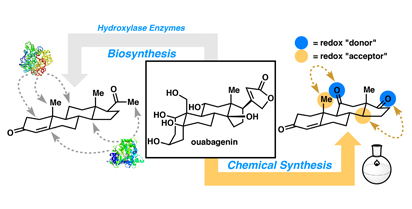Steroids that Only Nature Could Make on a Large Scale—Until Now
Scientists at The Scripps Research Institute (TSRI) have achieved a feat in synthetic chemistry by inventing a scalable method to make complex natural compounds known as “polyhydroxylated steroids.” These compounds, used in heart-failure medications and other drugs, have been notoriously problematic to synthesize in the laboratory.
The researchers demonstrated the new strategy by synthesizing ouabagenin [wa-bah-jenn-in], a close chemical cousin of ouabain, which Somali tribes once used as a potent poison on the tips of their arrows but was later developed as a treatment for congestive heart failure. This achievement, reported in the January 4, 2012 issue of Science, points the way to a scalable formation and modification of a variety of useful compounds that had been obtainable in significant quantities only from plants or animals.
“Previous synthetic routes to these compounds required so many steps as to be impractical on a large scale,” said Phil S. Baran, a professor and a member of the Skaggs Institute for Chemical Biology at TSRI, “but we were able to come up with a completely new strategy.”
Looking for Answers
The Baran laboratory has a longstanding interest in the practical and scalable synthesis of complex natural products. The group’s latest achievement was stimulated by a request from a Denmark-based drug company, LEO Pharma, whose chemists sought an efficient way to make complex, bioactive steroids. “We decided to go for the most complex member of the family, ouabagenin, which is probably the most polyhydroxylated steroid known on planet Earth,” said Baran.
Polyhydroxylated steroids have four carbon-based rings and are adorned with several hydroxyl groups, giving these molecules a high oxidation level and making them very difficult to synthesize and modify using simple methods. “Ouabagenin has six of these hydroxyl groups, which also exist in a lopsided orientation,” said Hans Renata, a graduate student in the Baran laboratory who was first author of the study. “This confers a strong directionality on ouabagenin molecules, so that they tend to stick even to inorganic material such as laboratory glassware, especially on small scale.”
In 2009, the Baran laboratory reported in Nature a holistic approach to synthesizing a class of natural products called terpenes (see News & Views article describing that discovery). This approach includes a laboratory “oxidase phase” that relies on the direct incorporation of functional groups (such as hydroxyl groups) into carbon–hydrogen bonds to reach highly oxidized terpene targets. Since steroids form a sub-category within the terpene family, the scientists hypothesized that these guidelines for terpene construction should apply to the synthesis of steroids, and in particular, to ouabagenin. Organic chemists have traditionally propagated functional groups from one carbon atom in the molecule to an adjacent carbon atom, which could result in lengthy syntheses; a previous synthesis of ouabagenin had been completed by another research group in 2008, but in 41 steps. The Baran group sought to incorporate the logic of carbon–hydrogen functionalization and long-range functional group transformations for a completely new strategy toward ouabagenin.
Only 21 Steps
Putting this idea into practice, Baran and Renata devised a series of reactions to convert a common, cheaply available steroid, cortisone acetate, into ouabagenin. The process uniquely combines two broad strategies—redox relay and oxidative stereochemical relay—which essentially propagate functional groups to desired locations within the molecule to enable rapid modifications from the starting material to the final target. “From cortisone acetate to ouabagenin took us only 21 steps,” said Renata.
Although the scalable synthesis of such a difficult compound is itself a major achievement, the new approach also enables a versatile modification of hydroxylated steroids. “With our strategy, we can make even small changes at any part of the molecule,” said Baran. That could help pharmaceutical chemists, for example, to tweak the chemical structures of natural toxins such as ouabain to make them less dangerous and more therapeutic at high doses.
“LEO Pharma's collaboration with Professor Baran and his team has the potential to unlock the door to an array of new opportunities in our product discovery and research,” said Michael Sierra, the company’s director of external discovery.
In addition to Baran and Renata, the report, “Strategic Redox-Relay Enables A Scalable Synthesis of Ouabagenin, A Bioactive Cardenolide,” was authored by Qianghui Zhou, a research associate in the Baran laboratory. For further information on the paper, see http://www.sciencemag.org/content/339/6115/59.full.
The research was funded by LEO Pharma.

Send comments to: press[at]scripps.edu














